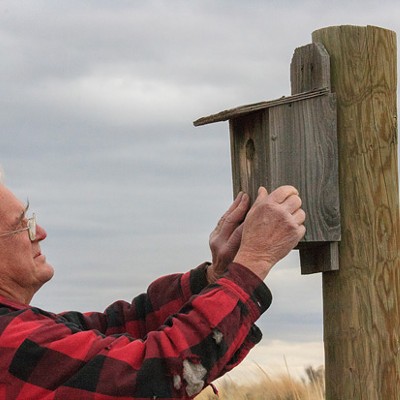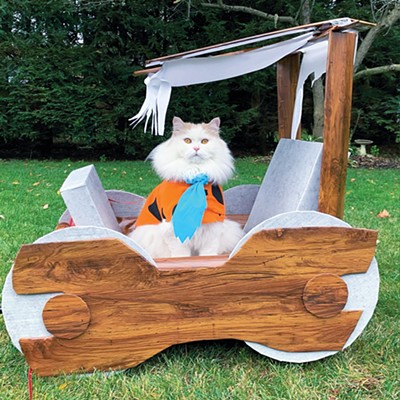OK, Good People; it's time. No, it's way past time to have a serious discussion about cats, disease and wildlife. Yes, I know, we've been down this muddy old road before, but it isn't just the losses of our native birds, mammals and reptiles by outdoor and feral cats that needs to be discussed and fixed, but the terrible spreading of disease from cats to people that's happening.
Dr. George Fenwick, a Johns Hopkins-educated pathobiologist, and current president of American Bird Conservancy, recently said, "The number of domestic cats in the U.S. has tripled in the last 40 years. Both owned and un-owned cats have increased to as many as 188 million."
"Not only do studies show that these cats are killing 2.4 billion birds and 12.3 billion mammals each year," he continued, "they are also contaminating our beaches, parks, oceans, rivers, and residential areas with a dangerous parasite, Toxoplasma gondii, that will remain viable for long periods of time. Hundreds of millions of infectious eggs may be deposited in these areas by a single infected cat."
The link among cats, T. gondii, and humans is documented in many studies. According to one such study, up to 74 percent of cats in the United States will become infected with T. gondii during their lifetime. Research from scientists at the Stanley Medical Research Institute and Johns Hopkins University, stated "Because cats are now so ubiquitous in the environment, one may become infected [with T. gondii] by neighboring cats which defecate in one's garden or play area, or by playing in public areas such as parks or school grounds."
While a T. gondii infection may not show symptoms, medical professionals state, dormant cysts in the human brain or elsewhere may still cause lasting effects, while infections are potentially fatal to people with a dysfunctional immune system that can cause spontaneous miscarriage in pregnant women or birth defects. Some preliminary studies also suggest that chronic infection T. gondi may be linked to schizophrenia or suicidal behavior.
These are heavy duty health hazards, as the connection with cats—the sole, definitive host of this parasite—is unquestionable. The Old Wives Tales regarding pregnant women staying away from cats actually has validity when researchers found that almost 80 percent of mothers of congenitally infected children contracted their infections as a result of environmental contamination from cat feces.
"Our civic leaders are either ignoring or embracing practices that foster burgeoning populations of feral cats," Fenwick said, recently. "The consequences will be felt for decades, if not longer, by both the suffering cats and people. Those officials continue to accept the emotionally laden arguments of cat advocates, suggesting that feral cats pose no harm to the environment or to their communities—in contrast to a mountain of peer-reviewed science saying just the opposite."
And adding to that mountain of science are the Center for Disease Control, the Smithsonian Migratory Bird Center, U.S. Fish and Wildlife, and now the Wildlife Society, all of which are calling for action on the issues associated with exploding feral cat populations in the US.
Which leads us to Trap Neuter and Release, commonly known as TNR, touted by many cat managers as a humane solution to problems posed by feral cats. Promoters claim it will reduce cat populations, but science tells us that TNR puts wildlife in peril while failing to bring cat populations under control or address related health concerns.
TNR advocates describe cats as territorial animals that stay in their home range and keep new cats out. Not so, says the Wildlife Society, which has looked at TNR long and hard. In fact, resident cats do not keep newcomers from feeding or joining the colony, and enough cats are dumped illegally or attracted to the food supply at TNR colonies to outweigh losses due to death or adoption.
A study on Catalina Island, Calif., monitored the movements of sterilized and intact cats from managed colonies, found no difference in range sizes of the two groups. Cats still moved away from the feeding stations into the more rugged adjacent lands, decreasing the feasibility of trapping all animals and increasing their ecological impact, making a living off the indigenous wildlife.
It also appears that the majority of TNR cats are not vaccinated, creating a major public health concern. The actions of Maddie's Fund, a pet rescue organization—which paid members of the California Association of Veterinary Medicine to neuter or spay feral cats—but did not require them to vaccinate or otherwise treat the cats. Ultimately, over 90,000 cats were released without rabies vaccinations.
Managed cat colonies are often claimed to be the cheapest form of control for areas with feral cats. In Akron, Ohio, nearly 2,500 cats were trapped from public parks. Of these, approximately 500 were adopted while the remaining 2,000 feral, diseased, or injured cats were euthanized. The entire project cost less than $27,000.
At the costs paid by Maddie's Fund in California ($50/neuter, $70/spay), sterilizing just 500 cats would cost approximately $30,000, in addition to the costs of trapping, euthanasia for the sick or injured, and subsequent feeding of all the rest.
Wildlife professionals and managers can and should address all legitimate threats to wildlife—epidemiologists should be looking at the diseases feral cats spread, especially to household outdoor cats. TNR does not live up to the many promises its proponents make: it has been shown to fail at decreasing feral cat populations, protecting native wildlife, addressing public health concerns, controlling pests, and reducing costs. Clearly, this misguided management tool should be uniformly rejected.
So, what is the answer to managing the expanding population of feral cats, and the cat-owners who have their heads in the ground? Registering all cats, and if it doesn't have a tag, it is humanely euthanized.


























